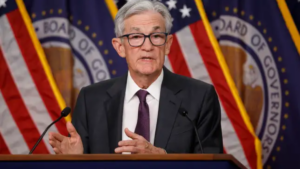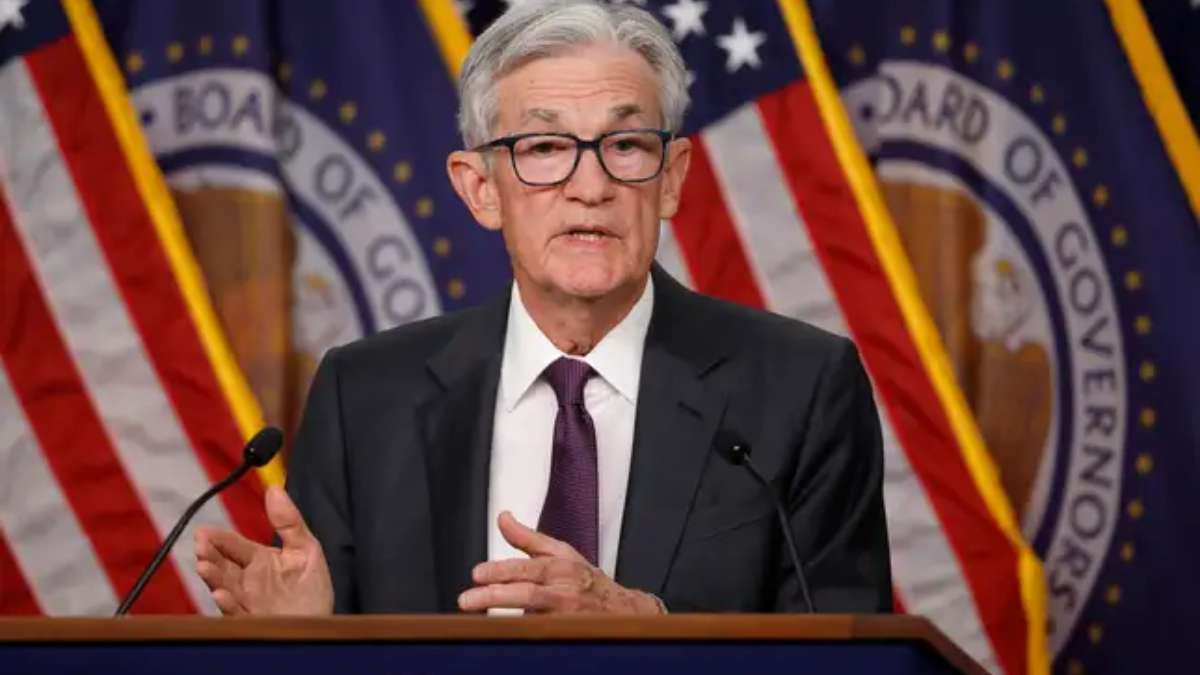The global equity markets witnessed a dramatic selloff on April 4, 2025, with major US indices falling sharply following Federal Reserve Chair Jerome Powell’s comments on tariffs and economic uncertainty. The Nasdaq officially entered bear-market territory, while the S&P 500 and Dow Jones both plunged more than 5%, signaling intensifying fears of a global recession triggered by renewed US-China trade tensions.

Powell’s Warning Adds Fuel to Market Fears
Federal Reserve Chair Jerome Powell stated that President Donald Trump’s newly imposed tariffs were “larger than expected” and warned of rising inflation and slowing economic growth. Powell’s reluctance to commit to immediate monetary intervention has left markets bracing for prolonged instability.
China Retaliates: Global Selloff Follows
China’s announcement of sweeping tariffs on all US imports in response to the Trump administration’s levies caused panic across markets. The escalation in trade tensions prompted investors to flee riskier assets, leading to:
- Sharp decline in US Treasury yields
- Recoil in gold prices after recent highs
- Further dip in crude oil due to recession concerns
Voices from the Market
David Seif, Nomura: “We’re far from a Trump or Fed put. Trump can remove tariffs, but the Fed’s tools are limited.”
Mike Mayo, Wells Fargo: “This is another resilience test for banks post-SVB crisis. Increased reserves are expected due to recession risks.”
Jeff O’Connor, Liquidnet: “Tariff unpredictability has stalled institutional participation. Market health may not recover soon.”
Michael Rosen, Angeles Investments: “These policies will lead to slower growth and elevated inflation. This selloff is the market adjusting to that reality.”
Joe Rinaldi, Quantum Financial Advisors: “Powell’s stance is middle-ground, but rate cuts may still be needed by summer if slowdown continues.”
Carol Schleif, BMO Private Wealth: “Today’s drop shows a lack of buyers. Investors await clarity after the weekend.”
Kevin Philip, Bel Air Investment Advisors: “If Trump doesn’t pivot, this could harm middle-income Americans and threaten his own agenda.”
Peter Cardillo, Spartan Capital: “Powell’s message hasn’t changed much, but the lack of Fed action disappoints markets.”
Gene Goldman, Cetera Investment Management: “Powell’s words hint at less aggressive rate cuts. Inflation remains his main concern.”
Global Perspectives on Japan’s Market Fallout
Chris Scicluna, Daiwa Capital: “Wealth destruction is widespread except in fixed income. Lower yields are hurting bank margins.”
Fred Neumann, HSBC: “Japan’s rate hike prospects are dimming due to tariff fallout. BOJ’s policy flexibility is narrowing.”
Sean Taylor, Matthews Asia: “Markets now doubt BOJ’s ability to hike rates. Banks are responding negatively.”
Michael Makdad, Morningstar: “Japanese banks may be overvalued if tariffs persist and recession hits.”
Jon Withaar, Pictet Asset Management: “We prefer sectors like real estate and construction that benefit from lower rates and aren’t exposed to tariffs.”
Conclusion
The steep plunge in markets underscores rising fears over a prolonged trade war and the Fed’s limited room for intervention. As investors grapple with uncertainty, all eyes remain on upcoming data for signs of inflation, jobs impact, and further policy shifts.
FAQs
Why did markets crash in April 2025?
Markets fell due to Powell’s warning on tariff impact, China’s retaliation, and fears of a global recession.
What did Powell say about the tariffs?
Powell noted that the new tariffs are larger than expected and could result in higher inflation and lower growth.
Which index entered bear territory?
The Nasdaq officially entered bear-market territory after dropping more than 20% from its previous highs.
Will the Fed cut interest rates?
While rate cuts remain a possibility, Powell has not committed to immediate intervention due to inflation concerns.
What sectors are at risk?
Banks, tech, and trade-sensitive sectors are most at risk, while real estate and construction may offer safer exposure.
Click here to know more.
Aanchal is a passionate writer with a keen interest in storytelling, content creation, and creative expression. She enjoys exploring diverse topics and crafting engaging narratives that captivate readers.

